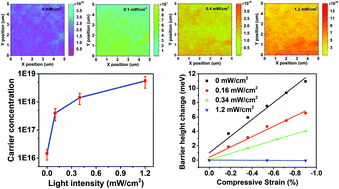Influence of the carrier concentration on the piezotronic effect in a ZnO/Au Schottky junction†
Abstract
The piezotronic effect, which utilizes the piezopotential to engineer the interface characteristics, has been widely exploited to design novel functional device or to optimize the device performance, which is intimately related to the carrier concentration. Here, by constructing a general Schottky diode, the piezotronic effect dependence on the carrier concentration was investigated systematically using ultraviolet (UV) illumination. Scanning Kelvin Probe Microscopy was employed to quantify the carrier concentration in ZnO nanorods under UV illumination. The results showed that the carrier concentration increases with increasing light intensity and an average value of up to 5.6 × 1018 cm−3 under 1.2 mW cm−2 light illumination was obtained. Furthermore, with increasing UV light intensity, an increasingly imperceptible variation in the current–voltage characteristics under strain was observed, which finally disappeared under 1.2 mW cm−2 light illumination. This phenomenon was attributed to the weakened modulation ability of the piezopotential due to the strengthened screening effect. In addition, the gradual disappearing in the barrier also contributed to the gradual disappearance of the piezotronic effect. This study provides an in-depth understanding of piezotronics, which could be extended to other piezoelectric devices and guide the design and optimization of piezotronic and even piezophototronic devices.


 Please wait while we load your content...
Please wait while we load your content...